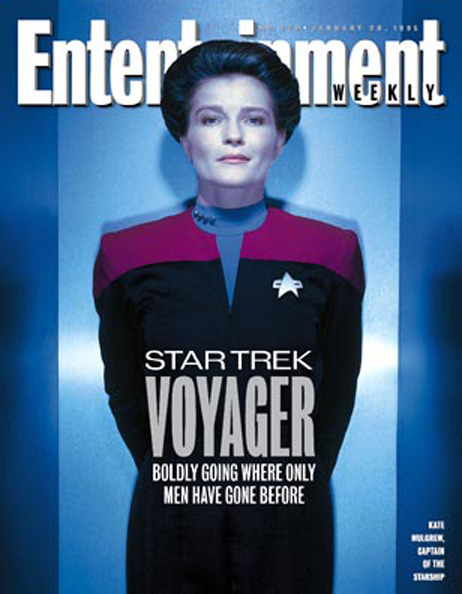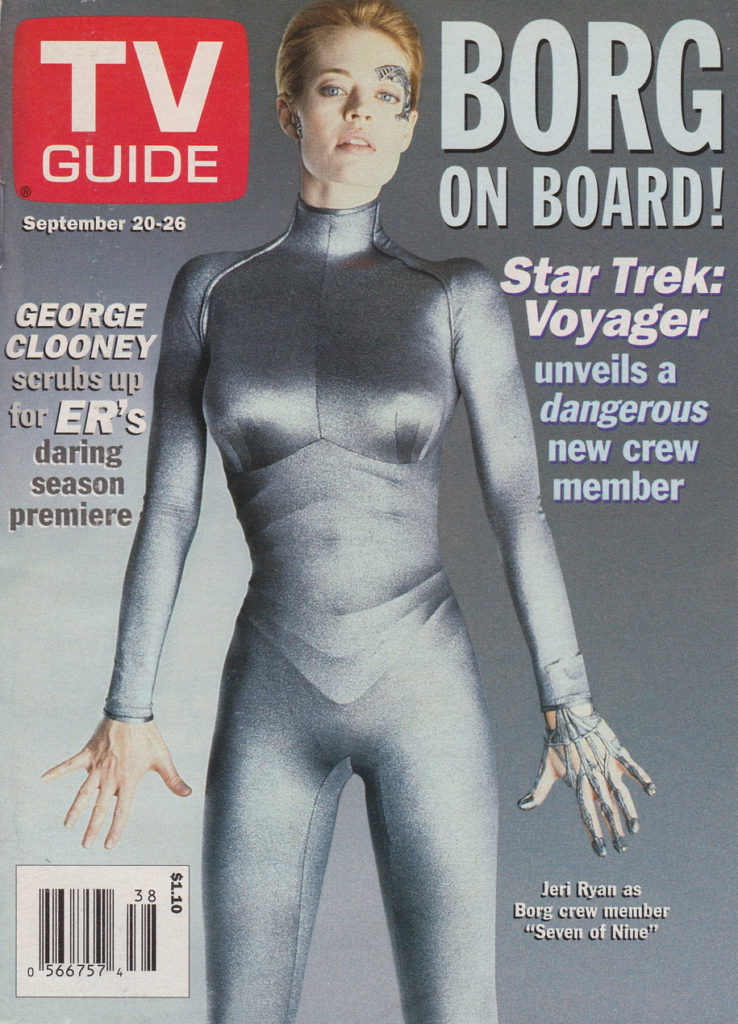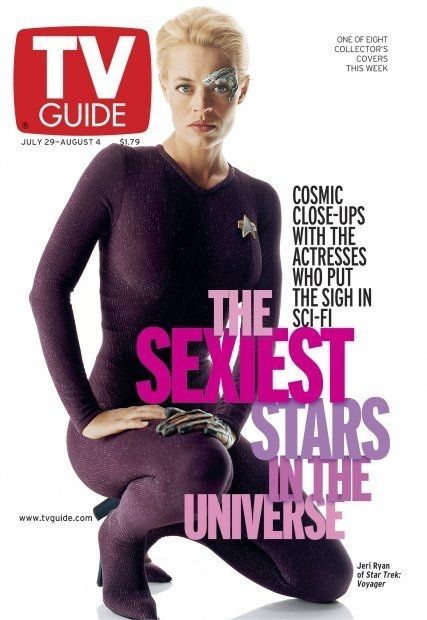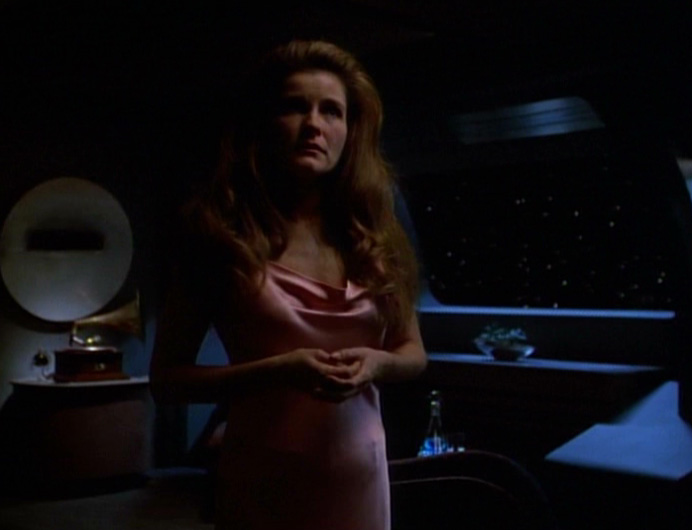
Twenty-five years ago, the Star Trek franchise built a new series around a female captain for the first time in its history. This had a tremendous impact on women and girls of that era. Congresswoman Alexandria Ocasio-Cortez, astronaut Samantha Cristoforetti, and rightful Georgia Governor Stacey Abrams all cite Star Trek: Voyager’s Captain Kathryn Janeway as a childhood hero.
But while this milestone and its impact deserve continued celebration, we must also acknowledge that Voyager did not realize its full potential as Trek’s feminist breakthrough. Its horizons were limited by the preoccupation with beauty, likability, and the male gaze that plague almost all female “firsts” in one form or another.
But now, a quarter century later, we’ve been afforded a rare chance to rectify that missed opportunity.
When Voyager premiered in 1995, the television business was getting crowded. Networks were taking production in-house, studios were starting their own networks to defend their turf, and video games and web surfing were drawing lucrative eyeballs away from prime time television.
At that time, males 18-40 were the most sought-after demographic among advertisers, and therefore among network heads as well. Despite the increasing competition for their attention, executives at UPN – one of two new television networks to launch that year – were confident their Star Trek spinoff could draw them in. They made bold promises to advertisers and pulled out all the stops on marketing; heavily promoting the story of award-winning theatre and television actress Kate Mulgrew playing the first female captain to lead a Star Trek series.
Female leadership is rigorously scrutinized by default, so the creation of the first female Star Trek captain was always going to be fraught. But with the viability of an entire network riding on Voyager’s ability to hold young men’s attention, that scrutiny was ramped up to a fever pitch.
In true Star Trek fashion, producers responded to this tension by playing up Janeway’s femininity and sex appeal. This put them in an ongoing tug-of war with Mulgrew, who wanted to be taken seriously and objected to their incessant fussing with her wig and attempts to get her character into bed with Commander Chakotay, her hunky but strictly off-limits subordinate.
“I had to put my foot down,” Mulgrew said of this dynamic during Q&A at Dragon Con in 2009. “I went to the [network] heads and I said, ‘you don’t understand. It’s fine for Bill Shatner to be hopping from planet to planet, or even Mr. Stewart, God bless him. But I don’t think I – and I was of childbearing age – can do this. I want [the audience] to regard me seriously as a commander.”
Producers eventually relented, but it came at a price Mulgrew hadn’t anticipated.
Three years after Voyager’s premiere, things were bad at UPN. Voyager had been the only show in their first-season lineup to generate any real ratings. Affiliate stations were dropping the network in droves. Despite the popularity of Brandy Norwood vehicle Moesha and superhero cop drama The Sentinel, the pressures of a diversifying media market had rendered UPN’s ratings commitments unreachable; requiring expensive recompense to advertisers. As a result, the network was hemorrhaging $160 million per year.
 Producers were desperate to grab the attention of their target demographic. Since the leading lady of their flagship show had made it clear she wasn’t going to sacrifice her character’s credibility for anyone’s titillation, they created a new character who would serve that function instead.
Producers were desperate to grab the attention of their target demographic. Since the leading lady of their flagship show had made it clear she wasn’t going to sacrifice her character’s credibility for anyone’s titillation, they created a new character who would serve that function instead.
Thanks to great writing and a stellar performance by actress Jeri Ryan, Seven of Nine brought as much substance as sex appeal to Voyager; but Mulgrew was nevertheless uncomfortable with the introduction of a character who was so overtly objectified that her costume consisted of a skintight “dermaplastic garment,” high heels, and little else.
“I was hurt, stunned a little bit,” Mulgrew said at a 2006 convention in Bournemouth, England. “Based on my dictates to the authorities that I was not going to have sex, I really thought Paramount, in its forward-reaching philosophy, would give it a shot based on the female owning the captain’s seat. I guess they felt terribly frightened that the young men would not stay alert enough without the excitement of sexual figure.”
What happened next has been the subject of much discussion, especially in recent years. Multiple cast members have said on the record that Voyager went from being a joy to film to a very uncomfortable environment, as Mulgrew fought with producers about the show’s shift in focus, lost, and turned her anger on Ryan.
“This is on me, not Jeri,” Mulgrew said in a 2015 interview. “I’m sorry it has to be part of this legacy, and I probably should have comported myself better.” But while Mulgrew’s willingness to own her role in the fracas is laudable, I struggle with the implied framing that either woman was fully to blame.
 Mulgrew was an actress in her 40s, an unenviable thing in Hollywood, playing a character she was madly in love with. She’d fought tooth and nail to establish Kathryn Janeway’s credibility within a tradition that had spent decades centering male leadership. I can’t imagine how galling it must have been for her to be freed from producers’ demands on her character’s appearance and love life only once they’d found someone younger to objectify.
Mulgrew was an actress in her 40s, an unenviable thing in Hollywood, playing a character she was madly in love with. She’d fought tooth and nail to establish Kathryn Janeway’s credibility within a tradition that had spent decades centering male leadership. I can’t imagine how galling it must have been for her to be freed from producers’ demands on her character’s appearance and love life only once they’d found someone younger to objectify.
Ryan was a relative newcomer who’d just gotten her big break: a role that initially required her to wear a full-Borg rubber suit that pressed on her carotid artery so she needed an oxygen tank to breathe between takes. And as if that wasn’t hard enough, she also had to contend with a leading lady who was channeling her resentment in the wrong direction.
It was the network heads and Voyager’s producers who created a toxic situation by effectively pitting these two dedicated actresses against each other in the quest for ratings. They needn’t have done so. UPN could have achieved their goals much more easily if they’d pivoted their demographic targeting to the people who were already watching and pursued advertisers who wanted to reach them.
Who were those people?
In the 29 years between the original Star Trek’s premiere and Voyager’s, the median age of first marriage for women rose by five years and the pay gap decreased by 14%. Women had disposable income and were making most household purchasing decisions.
Between the success of Moesha among Black teen girls, and Voyager’s appeal to women of all ages, UPN was already well on its way to cornering the market on smart, modern women. It would have been a natural pivot; one that carried the added potential of drawing in the millions of women and girls who had been living and breathing Trek since long before Voyager came along.
I was one of those girls. I’d been obsessed with Trek since I first saw The Next Generation at age 6. I watched Voyager religiously for seven years; but none of the men’s razors, luxury cars, or beer brands offered up during the commercial breaks appealed to me. I’m not alone. Of the Voyager fans I surveyed who watched the show on UPN during its original run, only 7% said they felt that they were the target market for the advertising.
What’s especially sad about this missed opportunity to court female viewers as a target demographic is that Voyager was, perhaps inadvertently, playing to the female gaze in its earliest episodes. For example, in “Eye of the Needle” (1×06), there is a scene where Janeway is roused from bed by an audio-only transmission from a Romulan captain with whom she must negotiate the delivery of a message to Starfleet.

When she pulls back the covers, we see that she is wearing a peach silk nightgown, with her long hair cascading over her shoulders in soft waves. I remember every detail of where I was when I first saw that scene, so compelling was the sudden electricity that coursed through my body when the light touched her face. I was eleven years old and I was madly in love.
I have no idea how Mulgrew felt about that nightgown, and I’m well aware that this scene was designed to reassure audiences of Janeway’s nonthreatening femininity, not to quicken the pulses of young girls; but it was a transformative moment for me. In the space of a few seconds, I simultaneously realized that I was queer and understood with certainty that a girly girl like me could do absolutely anything; including using my voice to turn an enemy into a friend.
Over the next few years, I went from lackluster student to academic powerhouse. I asked myself, “what would Janeway do?” in response to every conceivable obstacle and demanded to be sent to an all girls high school so I could focus on studying without the distracting antics of my male classmates. Like Ocasio-Cortez, Cristoforetti, Abrams, and millions of other women and girls, Captain Janeway changed the course of my life.
Fast forward to today and CBS (which now owns Star Trek) seems to have gotten the memo that women watch Star Trek and just about everyone loves great female characters. Star Trek: Discovery – which boasts a Black female lead, a plethora of complex female supporting characters, and Trek’s first gay couple – has become one of the most in-demand streaming series in the world with nary a dermaplastic garment in sight.
Buoyed by this success, CBS is further expanding the Trek franchise. Star Trek: Picard will premiere on January 23, picking up with The Next Generation’s Jean-Luc Picard 17 years after we last saw him. Picard will feature other TNG actors including Brent Spiner as Data, Marina Sirtis as Deanna Troi, and Jonathan Frakes as William Riker; and since Star Trek loves a crossover, Jeri Ryan will reprise her role as Seven of Nine.
The person who is sadly missing from this lineup is Mulgrew; this despite the fact that Voyager boasts higher online fan engagement than The Next Generation, with the most Netflix streams and most prolific fanfiction community of any Trek spinoff. And while fans will undoubtedly get a delightful Voyager fix from Seven of Nine’s presence on Picard, the vast majority of Trekkies I surveyed said Janeway is the Voyager character they most want to see.
Mulgrew says she’d be delighted to receive a call from CBS about giving Janeway a fresh new adventure, and CBS would be wise to make that call, given that 95% of the Trek fans I surveyed said they would watch a Star Trek: Janeway spinoff; just as many as said they planned to watch Picard.
So much could be done with a Star Trek: Janeway series. I can’t imagine Kathryn Janeway would let anything slow her down in her 60’s. She’d probably be running an elite division of Starfleet dedicated to every conceivable kind of scientific research. This would lend itself to any number of anomaly-of-the-week episodes, or to a season-long story arc about an experiment run amok or a scientific espionage drama.
As for her relationships, after watching her spend seven years adhering to command protocols, it would be heartening to see Admiral Janeway surrounded by friends who are not her subordinates. CBS might even go so far as to court Mulgrew’s ardent queer following by introducing a female or non-binary love interest. It would be refreshing to see Janeway represented as romantically and sexually fulfilled in terms that have nothing to do with youth, men, or the holodeck.
But however they do it, one thing is clear: the missteps of Voyager’s initial run have left CBS executives with an opportunity to make right what the brass at UPN got wrong 25 years ago. It’s time for Star Trek to revisit Janeway with a new story that re-engages her millions of fans, introduces the character to a new generation of Trekkies, and lets Mulgrew simply, finally lead.
—-
Tae Phoenix is a singer-songwriter, culture jammer, and community organizer from Seattle, WA. Her hobbies include obsessing over Star Trek and yelling at drivers to get out of the bike lane. You can find her at @taephoenix almost anywhere your personal data is being sold, or at taephoenix.com. She would like to thank the members of the Voyager Book Club for their help in researching and editing this piece, especially curator and Caladeniablue.
I am a huge ST fan, and one of my favs was Voyager. Captain Janeway was a resourceful and outside the box Commander. Her crew were dedicated to her b/c her style of management demanded excellence, mutual respect, and intelligence. I liked that her background as a scientist informed a lot of her decison making. When she faced down enemies in the Gamma quadrant, whether they be the Hirogen or the Borg Queen herself, they all had every reason to fear Janeway. I am also enjoying the hell out of Discovery as it gives the ST franchise a fresh injection of new ideals and has literally lifted the the story bar to ponder a struggling Starfleet, where help is not on the way. That’s what I liked about Voyager, Janeway operated in a no backup universe. Her vessel was for all intents and purposes, Starfleet, but what a ship it was under her her command! Janeway pushed Voyager’s technology to impressive feats of ingenuity, resilience, and adaptivity. Where as ST often got into the lazy habit of using the destruction of Enterprise (again?) as a tired plot point that signaled, “We’re in REAL trouble now!” it also made us question the Enterprise’s place as the flagship. Janeway did not have the luxury of having Starfleet build her another Voyager-A. Her ship and her crew treated it like it mattered because it was the only one they had. Voyager crossed the galaxy returning not only in one piece, but with technology that no doubt influenced ship design for generations. Not to mention Voyager’s database full of encounters with species so terrifying that it makes the Romulans seem quaint in comparison would fill textbooks at Starfleet academy for years to come. Janeway wrote the book on many things. I’d be all in on a reboot.
Hi, I just wanted to let you know this is an amazing article and you hit the nail on the head. The network really messed up what they had with Janeway. When the show premiered I was a 9 year older boy who was SO EXCITED there was going to be a new Star Trek series. I had the TV guide poster foe the show’s premiere hung up prominently in my room for years, until we moved from that house (4 years after Voyager ended).
I think it was tremendously helpful, as a straight male, to have Kathryn Janeway as a role model. Not as important, probably, as it was for girls the same age, but I adore Captain Janeway and her leadership, intelligence and dedication. I was impressed by her as a Starfleet officer, not as a sex object, ans I can’t help but think that that’s a big part of how I avoided a lot of the toxic masculinity that young men are bombarded with in our culture. She’s still a role model, and I would love the chance to see a Janeway reboot.
I am in that male demographic but have always loved Star Trek for the utopian vision it represents. This was a wonderful article. Thanks for opening up my eyes even further.
Interesting and enlightening read…I am a long time Star Trek fan. What almost made me stop before I’d really started was your “Georgia’s rightful governor….” bit. I live in Georgia, and Ms. Abrams was NOT elected.
How many Black voters have to be kicked off of the rolls before you consider an election sttolen, Dru?
From “Next Generation” to “Enterprise”, a Trek series has always featured a female cast member in a catsuit. I’m not excusing the franchise’s producers. Frankly, I found this extremely annoying and insulting. But yeah . . . Seven of Nine was not the sole character in a catsuit. Other characters included:
Deanna Troi – TNG
Kira Nerys – DS9
Kes (late Season Three to early Season Four) – VOY
Seven-of-Nine – VOY
T’Pol – ENT
And both TOS and the Kelvin Trek movies featured the usual miniskirts “Deep Space Nine” tend to occasionally feature the Bajoran character Leeta, displaying a good deal of cleavage. Troi’s catsuits also featured some cleavage as well. She didn’t start wearing a Starfleet uniform until late Season Six or Season Seven. Very frustrating for female fans of the franchise and for some of its actresses.
Yes the men had it wrong the Voyager audience was beyond the so called demographic, it had much wider appeal. I think the male top brass did a disservice to Kate by dumping 7 of 9 in a catsuit in the series and creating tension in the work environment. It’s time to rectify that mistake. Bring Kate back as Janeway There’s a huge audience.
Very well said. I’m a huge Janeway fan & it meant a great deal to see a woman in charge.
Is AO3 or fanfiction.net a better measure of most prolific community? Voyager is #1 on FFN but #2 on AO3. The question gets even more tricky when you try to measure the most popular couple on a show.
I would watch the hell out of a new Janeway show… as long as it’s Kate!
Thank you, Tae, for speaking out for Kathryn Janeway. Trailblazing is hard, but she — and Kate Mulgrew — did it responsibly and thoughtfully. They remain worthy of our admiration all these years later.